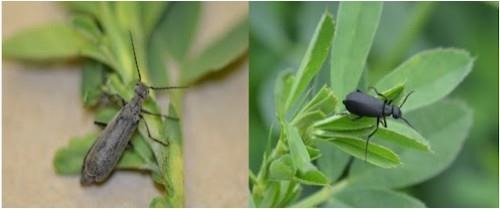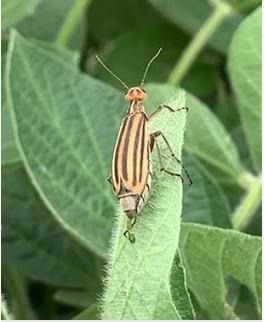By Jared Goplen and Krishona Martinson et.al
There have been an increasing number of blister beetle sightings in Minnesota alfalfa fields this year. Blister beetles are rarely problematic in Minnesota, but the drought conditions have caused some concern for blister beetle-infested alfalfa. If consumed in hay or haylage, blister beetles can cause health problems and death in horses, cattle, sheep, and other livestock.
Key points
- Blister beetles have been found in many areas of Minnesota this year
- Blister beetles contain cantharidin, a toxin that causes health problems and death in livestock when consumed in large enough quantities.
- Horses are more sensitive to cantharidin than cattle, sheep, or other classes of livestock.
- To prevent issues, scout fields 1-1.5 weeks prior to harvest, avoid harvesting alfalfa beyond 10% bloom, and watch for beetle “swarms” during harvest.
What are blister beetles?
Blister beetles are attracted to and feed on the flowers, pollen, and leaves of blooming alfalfa and weeds. Adult blister beetles are long, narrow beetles (0.5 to 1.25 inches long) with a broad head and antennae that are straight and about one third their total body length.
Several species exist, including black, ash gray or striped beetles, each having unique color patterns (Figures 1 & 2). Striped and ash gray blister beetles seem to be the most common this year.

Figure 1. Ash gray (left) and black (right) blister beetles.
Blister beetles tend to be more numerous in alfalfa that was produced in arid southern states and plains states where grasshoppers are problematic, because developing beetles feed on grasshopper eggs. As a result, blister beetle populations are typically greatest in areas where grasshoppers were present the prior year.
Blister beetles produce a defensive compound called cantharidin. Striped blister beetles contain more of this compound than black or ash gray blister beetles. The level of cantharidin produced is highly variable and released when the beetle is crushed during hay making. Cantharidin remains toxic in dead beetles and does not decrease during storage.

Figure 2. Striped blister beetle.
Horses are more sensitive to cantharidin than other types of livestock, though they express similar symptoms when great enough quantities of cantharidin are consumed. When eaten, specific symptoms in horses include the following:
- sores or blisters on the tongue and in the mouth
- colic
- straining
- increased temperature
- depression
- increased heart and respiratory rates
- dehydration,
- sweating
- diarrhea, bloody feces, and frequent urination.
If you suspect cantharidin poisoning, contact your veterinarian immediately. There is no specific antidote beyond supportive care, which includes mineral oil, intravenous fluid therapy, activated charcoal, and analgesics.
Minimize risk at harvest
Although the risk of harvesting blister beetles in hay cannot be eliminated, it can be minimized by scouting alfalfa fields prior to harvest and by cutting hay before full bloom. In the Midwest, beetle populations are relatively low until mid-summer (e.g. July and August), so first and second cutting tend to have minimal infestations. Beetles are more likely to be found in flowering alfalfa hay where grasshoppers were present the prior year, which was the case for areas of Minnesota last year.
Hay that is simultaneously cut and crimped with a mower conditioner is more likely to kill beetles, keeping them in the windrow. However, crimping speeds drying, which is important for harvesting quality hay. Live beetles will typically leave the windrow prior to harvest.
Cutting alfalfa at less than 10% bloom reduces the number of beetles. Farmers should watch for beetle "swarms” during harvest and stop to allow the beetles to disperse. Chemical control is possible if beetles are present but may not be the best option because dead beetles containing cantharidin may still end up in hay.
What can hay buyers do?
When buying hay, buyers should learn as much as possible about its production, including who produced it, where it was produced, and the cutting date and maturity at harvest. If details aren’t available, owners should pay close attention to alfalfa hay that was mature or flowering when harvested. It is nearly impossible to detect blister beetles while feeding contaminated hay. This is because the beetles tend to swarm, meaning only a few bales, or even just parts of bales from an entire field may be infested.
Source : umn.edu